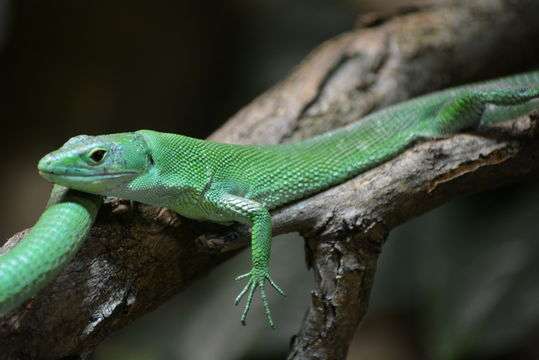
Description:
Scientific name: Gastropholis prasina
Life span: 10-15 years
The green keel-bellied lizard features a long, prehensile tail that makes up roughly 70% of its body length. It is a thin, bright green reptile. Its back has small, emerald-green scales that are smooth and do not overlap. Its underbelly has keeled, yellow-green scales. Around its limbs, there are turquoise patches, and occasionally there are black specks on its tail as well as lines along the sides of its body. It has a vibrant crimson tongue.
Native Region/Habitat
This species is confined to Kenya and Tanzania’s coastal plains. The coastal plain’s forests, woodlands, and thickets are home to G. prasina. It has been spotted both near the ground and higher in the canopy, where it may use small branches as perches.
Behavior:
This species is arboreal and active during the day. Although it typically only eats insects, it has been observed in captivity to consume smaller lizards. Males bite the female’s neck during mating behavior, and they also intertwine their tails. It has oviparity. It produces five-egg clutches in captivity in the early fall.
Care As a pet/In captivity:
Green Keel-Belly Lizards need a sizable enclosure that has plenty of height. An adult couple will prefer a cage that is 24x24x36 inches or bigger. It is possible to use a mulch or coconut coir substrate, but the vertical space and its climbing branches are more crucial because this tree-dwelling lizard will spend most of its time above the ground. The species will use the floor space and may look for hiding spots at the enclosure’s floor, but it does not belong in the “canopy species” category because it primarily inhabits the lower portions of the forests and woodlands where it lives. To make the terrarium attractive and to give hiding places, add driftwood, manzanita branches, clean, slender tree branches, and vines. You may also use huge plastic or silk plants. In the corners, vertical cork tubes or cork slabs leaning at an angle can serve as hiding places. There must be a lot of cover.

A basking lamp that is enclosed in a cage to prevent the lizards from touching the bulb should be used to produce heat. The bulb wattage should be selected so that the cooler end of the enclosure is closer to 70oF and the warm basking end of the enclosure approaches the mid-80s. The placement of branches or “shelves” should allow the lizards to thermoregulate by situating themselves close to the heat source, but care must be given to prevent them from touching the light bulb. Full-spectrum reptile illumination with moderate UVA/UVB levels is advised in addition to indecent basking lamps.
A variety of gut-fed and supplemented (with calcium dust) insects like crickets, kingworms, and roaches are part of a healthy captive diet.
Humidity: This lizard does prefer somewhat high humidity, as was already mentioned. It should, however, have a cage that is well-ventilated and dry. In order to cycle these lizards for reproduction, make the environment hotter and more humid during the rainy season in their natural habitat, which occurs in April and May. Then, during our summer, reduce both temperature and humidity levels.
Table





